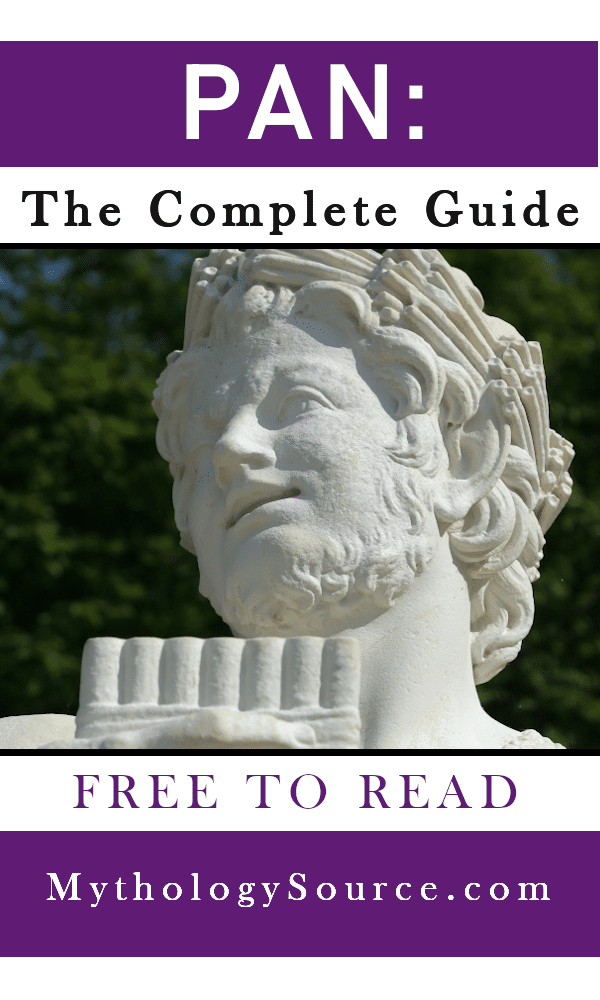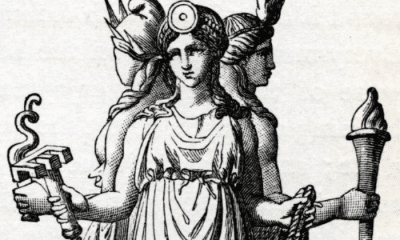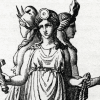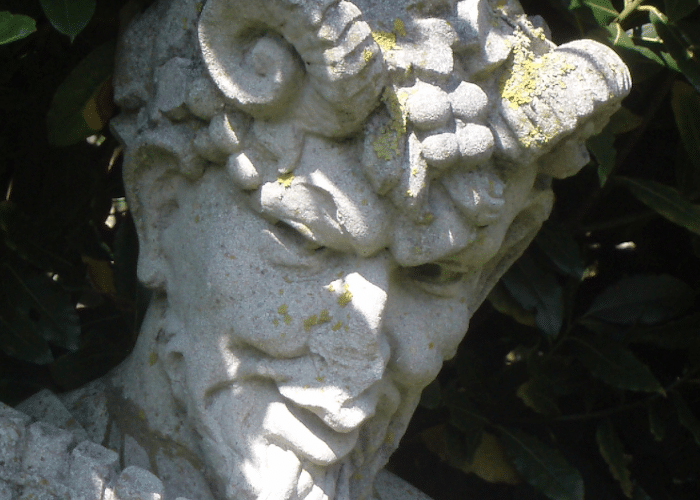
Greek
Pan: The Goat-Footed God of the Countryside
Pan: The Goat-Footed God of the Countryside
You’ve seen his goat like legs and heard his famous flute, but how much do you know about Pan the wild god of rustic life?
A goat-legged god who loved nature, music, and women – Pan might be the most unusual god in the whole pantheon!
But Pan, who the Romans called Faunus, wasn’t as bizarre as it might seem. While the Olympian gods represented the lofty ideals of the city, Pan was a bit more wild.
The god of the countryside, shepherds, and mountainsides, Pan had dominion over a side of Greek life that was closer to nature than the great temples and marketplaces of the city.
So where did Pan come from, and why do we remember him so well? Read on to find out more about the god with the legs of a goat!
The Origins of Pan
Out of the entire Greek pantheon, Pan might be the god who is most obviously a hold-over from a more ancient time.
Before people worshipped gods with a set hierarchy and family lines, they looked to nature spirits to explain the world. These earliest gods often combined traits of humans, animals, and nature itself.
As Greek culture and religion formed, some of these ancient nature spirits persisted. They were incorporated into the myths of the great Olympian deities.
Pan was one of these gods. While his character changed as he became part of the classical Greek pantheon, he remained a more wild spirit than his civilized counterparts.
Like most Greek gods, he was incorporated into the complex family tree of the Olympians. Most writers considered him a son of Hermes, although some attributed his parentage to Dionysus.
The myths rarely agree on who Pan’s mother was, although most consider her to be one of the thousands of nymphs. What many note, however, is that she was so horrified by her baby that she fled the site of his birth.
Pan was born fully formed, with the torso of a grown man and the legs and tail of an adult goat. Artwork often includes the detail of horns on his head, furthering his inhuman appearance.
And the Greeks almost universally agreed that Pan was not a good-looking god. He is usually shown with an unattractive face an full, unkempt beard.
As a child Pan had a pleasant demeanour and love of laughter, but this was widely overshadowed by his unattractive looks.
Hermes took the child to Mount Olympus where, despite his appearance, the other gods were delighted by him. Dionysus, especially, found Pan charming and they would go on to be closely associated.
Pan was raised by nymphs. In descriptions of him he is almost always dancing and playing games with them, a far cry from the more stoic and regal depictions of the Olympians.
The wild countryside he grew up in was far from the grandeur of Mount Olympus or the great temples of the cities.
Pan was most popular in Arcadia, the mountainous southern part of Greece. There, he was revered by shepherds and rural villagers in the rugged mountain territory.
The culture of Arcadia was among the oldest of the Greek lands. This probably explains why they most worshipped Pan, a god who almost certainly predated the rest of the pantheon.
In some accounts, there are multiple versions of the god. Some say the other Panes were sons of Zeus or Hermes by another mother. Others say Pan himself was their sire.
Most likely, the Pan that survived into the classical Greek era was just one of many nature spirits worshipped in early Arcadia. As Greek culture developed, he combined with other pastoral gods.
While Pan became a distinct character, the others were forgotten in all but a few stories.
The God of the Wild
Pan was the patron of all things related to the countryside, particularly shepherds. Having the bottom half of a goat, it’s no surprise that he was particularly associated with goats and sheep.
Shepherds have always lived solitary lives, spending much of the year tending to their flocks far from the comforts of home. Unkempt and wild, Pan appealed to those men who ranged the mountains and meadows with their sheep.
Pan was said to help them, appearing to give advice on when to move and where to go. For those living a rustic life he offered companionship.
Pan himself was a herdsman at times. His father Hermes had become a god of animal husbandry after stealing Apollo’s cattle, and Pan was often set to watch over his father’s sheep, goats, and cows.
Because Pan was a god who inhabited wild places, he did not have great temples. His worshippers set up simple altars in caves and groves, the places their god frequented.
Even in Athens, Pan’s temple was a rustic place. There he had his altar in a natural cave on the slopes of the Acropolis, in contrast to the great architecture of the Parthenon above.
Only two true temples in Pan’s honor are known to have existed. One, deep in a river gorge, survives as ruins. The other was built in Roman Egypt much later.
Pan also invented the amusement most often associated with solitary shepherds – the Pan pipes. This simple set of reed pipes became synonymous with the lonely herdsmen who played them to pass the time.
In later myths, Pan takes the place of Marsyas the Satyr in a music contest against Apollo.
The contest between Pan’s rustic flute and Apollo’s fine lyre was judged by Tmolus. The beautiful music Apollo made was deemed the winner.
King Midas, however, happened to be nearby and spoke up that he preferred Pan’s playing. Apollo cursed Midas with the ears of an ass, saying that his ears should be as uncultured as his mind.
While Pan could be a pleasant and helpful companion, he could also inspire dread.
Pan was said to be the source of fear and uncertainty that came upon people in the wilderness. Coming out from his caves at night, he sometimes startled flocks and caused them to run.
From his name, we get the word panic.
His panic could bring fear to solitary travellers, but it could also strike entire armies.
One legend in Athens claimed that Pan had saved the city by panicking an invading army. When the King of Cyzicus killed Cybele’s sacred lions, Pan avenged her by spreading panic through the whole city.
Spreading panic among flocks and men was a sport for Pan – just one of the many merriment’s he delighted in.
Pan and Myths of Wanderers
The Greek countryside was more than a place to tend to sheep and goats. With rugged mountains, deep caves, and hidden grottoes it was a favorite place for those looking to hide.
Spending his time in that landscape, it’s not surprising that Pan features prominently in myths involving a flight into the wilderness.
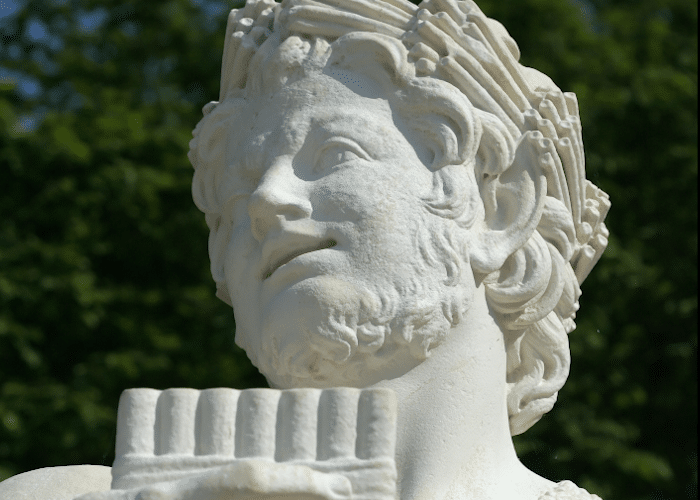
In one such story, Pan encounters the goddess Demeter.
Demeter’s beloved daughter, Persephone, had been abducted by Pluto and made queen of the underworld. Grieving the loss of her child, Demeter had abandoned Olympus.
Wearing a black cloak of mourning, she wandered the wilderness. Eventually, she shut herself in a cave to be completely alone in her suffering.
Without Demeter, though, the world began to die. Plants withered, causing a famine for humans and animals.
Knowing the mountains well, Pan set out to find the missing goddess. He eventually discovered her hiding place and reported it to Zeus.
Zeus sent the Fates, who persuaded Demeter to return to her duties.
In another story, Pan came across the beautiful princess Psyche.
Against the wishes of Aphrodite, Eros had fallen in love with the girl. He took her away, but made her promise never to look upon his face.
When Psyche broke that promise, Eros abandoned her. She wandered the world, searching for her lost love.
In her despair, Psyche considered ending her own life by throwing herself into a river. As she had this thought, Pan happened to come by.
Knowing what had happened to cause her misery, Pan tried to comfort the girl.
You are an elegant girl, and I am a rustic herdsman, but my advanced years give me the benefit of considerable experience. … You must hearken to me: do not seek gain to destroy yourself by throwing yourself headlong or by seeking any other means of death. Cease your sorrowing, lay aside your sadness, and instead direct prayers of adoration to [Eros], greatest of gods, and by your caressing attentions win the favor of that wanton and extravagant youth.
–Apuleius, The Golden Ass 5. 25 ff (trans. Walsh)
Psyche did not reply, but she did continue on her way. Eventually, she would win Aphrodite’s favor and be reunited with her husband as a goddess.
These legends did more than just tie Pan into the stories of the major gods. They reinforced his position as a companion to anyone who wandered the wilderness.
Whether someone lived a rustic life or simply found themselves lost in Arcadia’s miles of hilly wilderness, they could count on Pan to be nearby.
Lover of Nymphs
One of Pan’s most ancient functions was as a fertility god who ensured the successful breeding of his shepherds’ flocks.
Pan didn’t just guide the breeding of sheep and goats. His goat-like lower half was often shown with a prominent phallus.
In later Greek mythology, much of the role of a fertility god was taken over by the more gentle, civilised gods of Olympus. Eros shot his arrows to produce love and goddesses like Demeter and Hestia watched over home life.
But Pan’s role in procreation was never fully forgotten. He represented a more base, animalistic form of fertility.
Translations have sometimes seen women who had relations with several partners referred to as “Pan girls.” Pan didn’t oversee marriage – he oversaw more primal urges.
The base urges Pan was associated with often had less than pleasant connotations. The god of lonely shepherds, a statue recovered from the ashes of Herculaneum shows the god having relations with a female goat.
In the legends, Pan is often paired with the nymphs. These demigoddesses of wild places were numerous and often became the lovers and wives of the gods.
A lover of music and merriment, Pan was often found dancing with the nymphs and playing games with them. Sometimes these descriptions reflect the innocent simplicity of life in the country, but some call to mind fertility rituals and rites.
The nymphs themselves were generally less than welcoming toward Pan’s advances.
One description from the 3rd century AD goes on to say that the nymphs joked about how badly Pan danced, although he paid them no mind. When he was overcome with lust they would gang up on him to tie him up so they didn’t have to endure his advances.
In this story, they even shaved his beard to chastise him.
One of the most famous stories of Pan and the nymphs involved his invention of the reed flute.
Syrinx the wood nymph was a follower of Artemis, and as such had taken a vow of chastity. Pan met her as she returned from a hunt and instantly pursued the maiden.
Syrinx ran away until she reached the river that her father was the god of. She begged her sisters to help her evade the amorous Pan.
The other nymphs changed her into a reed. When the wind blew through them, the reeds by the side of the river made a sad, but beautiful sound.
When Pan came to the river he was saddened to find Syrinx gone. Not knowing which plant was her, he picked several of them.
Pan bound reeds of different lengths together, creating a set of simple pipes. From that day forward, he was rarely seen without his Pan flute.
The nymph Pitys similarly escaped Pan’s advances by turning into a pine tree.
The most famous nymph to attract Pan’s desire, however, was Echo.
Echo was beautiful and renowned for her singing and dancing. Many men fell in love with her, but she refused them all.
Pan, usually more lustful than romantic, fell deeply in love with the nymph. Some say he had angered Aphrodite and she had cursed him with the pain of unrequited love.
In one version of the story, Pan was so angered at her rejection that he ordered his followers to tear her apart.
The more famous story, though, is that Echo refused Pan because she was in love with another man. Narcissus, though, was vain and self-absorbed so he ignored the nymph entirely.
Echo had attracted Hera’s anger as well. She had used her beautiful voice to distract the goddess while Zeus amused himself with the other nymphs.
Hera cursed Echo to only be able to repeat what someone else said. Without her voice, Echo could not profess her love to Narcissus, so he continued to ignore her.
In this version of the story, love-sick Echo faded away until nothing was left of her voice. She forever wandered the world, repeating what others said.
Although Pan had failed to win Echo, the stories say he never stopped loving her. He played his flute in the mountains to hear her echo back the notes and the greatest threat anyone could use against him was to convince Echo to never let him hear her beautiful voice again.
While Pan’s pursuits of the nymphs often left him empty-handed, he was occasionally successful. One Latin author said that he succeeded in seducing Selene, the moon goddess, by wearing a sheepskin to cover his goat half.
Pan also succeeded in seducing some of the nymphs, as evidenced by the children he fathered. Among the offspring of Pan are:
- Silenus – The oldest, and drunkest, of Dionysus’ followers, Silenus was usually pictured with the ears of a horse.
- Lynx – Possibly the daughter of Pan and Echo, she cast the spell that caused Zeus to fall in love with Io. As retribution, Hera turned her into the bird that bears her name.
- Krotos – A fan of the Muses, he invented applause to praise their arts. He was immortalized as the constellation Sagittarius as a great archer and horseman.
- Acis – A Sicilian shepherd according to Ovid, he was killed by a Cyclops. The place where his blood flowed became a river at the base of Mount Etna that bore his name.
- Eurymedon – One of the defenders of the city in Seven Against Thebes. He was described as a wild-looking man who inspired his father’s panic in his enemies.
- Crenaeus – Another defender of Thebes, he was killed by Hippomedon.
- The Panes – Some stories explained the multiple versions of Pan as the twelve sons he had with various wild nymphs. Sometimes these additional Panes were differentiated from their father by having the heads of goats instead of the legs.
- Aegipan – The “goat-Pan,” stories differ on whether he was an aspect of Pan himself or one of his children. Sometimes seen with the tail of a water snake, Aegipan’s image was used for the constellation Capricorn.
Pan and Dionysus
Of all the gods, Pan is most closely linked to Dionysus.
The god of wine and feasting, Dionysus represented a release from the constraints of society’s rules and order. A wild god who loved music and sex, Pan was a natural companion for the god of parties.
Pan is often seen with, or conflated with, the Satyrs. These wild spirits with the tails of horses were similarly associated with wild merriment and unchecked sexuality.
The Satyrs and Pan were often the companions of the Maenads, the wild followers of Dionysus. Their worship was a wild, drunken revelry that often descended into a chaotic frenzy of sex and violence.
Pan’s son, Silenus, had served as tutor and foster-father to Dionysus. The two became virtually inseparable.
Association with Dionysus was not always about parties and revels, however. Even the god of wine went to war.
The story of the Indian War of Dionysus was a later one, from after the time of Alexander the Great. In his campaigns he had introduced the Greek world to India, and the Dionysiaca was an attempt to incorporate this new land into Greek tradition.
In this epic poem, Zeus tells Dionysus that he must convince the Indians to worship the gods of Olympus if he wishes to be counted as one himself.
Dionysus sets off in a war on India. His army is composed largely of his usual followers – the wild Satyrs, Maenads, and Panes – as well as more organized troops provided by Rhea.
Dionysus and his men easily overpower the Indians and the battle is a bloodbath. He takes pity on his enemies, turning the water of a nearby lake to wine.
This was the first time Indians tasted wine. When they had drunk themselves to sleep, Dionysus had them bound.
As one of his chief followers, Pan was a part of the army of Dionysus.
When the god attempted to talk to the Indian leaders, Pan was with the heralds sent. They were rudely chased away, inciting the anger that led to the great battle.
When the battle was over, Pan played his flute while the Greek and Indians enjoyed the ample wine Dionysus had provided.
The greatest expansion to Pan’s story comes at the end of the poem, when Zeus orders Athena to help the goat god. He claims that Pan fought beside him against the Titans and was shepherd to the she-goat that nursed him as a baby.
This embellishment contradicts the common stories of Pan’s lineage, but help to cement his position of importance among the great gods of Olympus.
A Lasting Image
The image of Pan cavorting with the nymphs and satyrs around Dionysus is a familiar one. It is not the only way in which Pan, and his likeness, have been passed down to us though.
As an obviously pagan deity, Pan had little appeal to people after the rise of Christianity. His wildness, eroticism, and association with the drunken revels of Dionysus put him at odds with the ideals of the medieval world.
When interest in Greco-Roman culture was revived in the Renaissance, Pan was still ignored. Those thinkers and artists preferred the refined and idealized nature of the Olympians to the rustic, animalistic Pan.
That view of Pan began to change in the late 17th century when interest in folk customs of naturalism grew. Pan became emblematic of the nature spirits and simple beliefs of the past.
In England, far removed from Greece in ancient times, a group in Gloucestershire even began an annual festival to Pan. One local vicar revived the festival when it had died out for a brief time, mistakenly believing that it was an ancient local custom.
By the Victorian era, however, Pan took on a less positive role in the popular imagination.
Spurred perhaps by the revival of neopagan festivals and writing, Pan became the most recent ancient pagan god to be portrayed as a demon in Christianity. His goat legs and horns became the standard depiction of Satan.
To this day the imagery of Christianity’s greatest villain is modeled on Pan.
Neopaganism took Pan as a universal archetype. Pan was just one aspect of the Horned God, seen in neopaganism and Wicca as the spirit of male virility and masculine sexuality.
Despite this, Pan was also adopted into children’s literature. Modern writers removed the sexual connotations of Pan’s myths and, through the Romantic lens of folklore, pictured him as a symbol of a more innocent time.
The god gave his name to Peter Pan, the lost boy who never grows up. The character plays the iconic reed flute and cavorts with mermaids the same way his namesake did with nymphs.
The goat-legged creature also introduces children to Narnia in The Lion, The Witch, and the Wardrobe. Many characters and places in C.S. Lewis’s series were modeled on Greco-Roman mythology and in later books Bacchus (the Roman equivalent of Dionysus) and his retinue of fauns (Panes) and satyrs make an appearance.
From the innocent delights of nature to the root of all evil, the image of Pan has endured into the modern era.
Pan was a God of All Things
The name Pan probably derives from a very ancient word that also gave us the root for pasture.
But the Greeks saw Pan in a much broader way. The word pan in Greek means “all.”
Philosophers sad that Pan’s name showed how he could have a hand in all things, be in all places, and influence all people.
While their notion of where the name came from was incorrect, these philosophers weren’t entirely wrong.
In the rural areas of ancient Greece, Pan really did touch on all aspects of life.
As the spirit of rugged terrain and the patron of herdsmen, Pan represented the isolation and individualism of rural life. As a god of sexuality and a partaker in Dionysus’ revels, he represented the joys of companionship and togetherness.
Stories of Pan show both the pleasant aspects of a life away from civilization, and the fear that comes from being alone in the wild.
When a shepherd sat alone in the hills with only the echoing sound of his pipe as company, he could pray to Pan. And when he returned to his village for music and merriment, he could also see Pan in his life.
Pan represented both the hardships and the joys of life in the country. For rural Greeks, Pan really was the god of all things.
